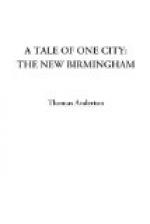If some outside people were asked to name in three lines the three chief trades of Birmingham they would probably answer by saying “Guns,” “Hardware,” and then, perhaps rather puzzled, might add “more guns.” This, however, would be a very bald and incomplete reply, and would denote a somewhat benighted idea of the productive resources of Birmingham. Gun and pistol making form a very important industry in the city, and one ward—St. Mary’s—is the happy hunting ground of small firearm makers. All the same, gunmaking is not the be-all and end-all of our manufacturing activity, and is, indeed, only one of the many and increasing trades that thrive and progress in the midland hardware capital.
It is, indeed, a distinct advantage for Birmingham that it has many different trades, and if some are depressed and slack others may be active and prosperous. Hence, there is generally business doing somewhere. It is the misfortune of some towns and districts to be devoted entirely to one or two industries. For instance, take Manchester. If the cotton trade becomes depressed or paralysed Cottonopolis soon becomes a starved-out city. Then there are textile towns, boot and shoe boroughs, pottery districts, &c., &c. Birmingham, however, is pretty smart at taking up new ideas, and does not let new manufacturing industries go begging for a home. A certain number of trades languish and die out owing to change of fashion and to certain articles becoming obsolete. Snuffers and powder flasks, for instance, are not in large demand in the present day. A limited number are still made for travellers and for remote countries that have not cartridges, the electric light, or even incandescent gas, within their reach.
Brass and pearl button making used to be important industries, and tons of such wares used to be made in Birmingham in the course of a month. Comparatively few are made now. Yet we are not exactly “buttonless black-guards,” as Cobbett—at least, I think it was Cobbett—once disrespectfully called the Quakers, and buttons of various kinds other than pearl and brass are turned out in barrow loads. I remember some years ago going over the button factory of Messrs. Dain, Watts, and Manton, an old-established business now carried on by Mr. J.S. Manton, and was then shown a curious composition or kind of paste that could be made into buttons useful for all sorts of purposes. On my asking what the “button dough” was made of, Mr. Manton, I remember, gave me the comprehensive reply, “anything.”
All sorts of stuff having any substance in it was indeed thrown into a kind of mortar, ground up, mixed with something that gave the mass cohesion and plasticity, then moulded into buttons as clay is moulded by the potter, and burned, dried, and hardened. Therefore, if brass and pearl buttons are in limited demand, there are other materials from which a new useful and cheap article can be made—the “very button” for the time—and this is produced in much larger quantities than the more costly articles of a few generations ago.




